An informal diary of our trip to Amsterdam, with pictures.
On our way
Sunday, 1 October
We left home at 5:45, ferried to the airport by Carolyn. Curbside check-in was closed, so we checked in at the counter, as required for international flights. This took a while as one customer was having some sort of problem that was taking the attention of three employees – I wonder, in this age of automation, what problems can still be had the require a gaggle of humans to resolve them. Anyway, we got checked in after a twenty minute wait, went through security, and made our way to the gate, waited again, and boarded the plane.
Although we were in a new-to-me seating category, “Delta Premium Select,” whose ads seemed to promise nearly reclining seats, they turned out to be pretty much like what used to be called “Comfort Plus,” perhaps with the addition of an inch or two of width. “Comfort Plus,” now, I believe, just called “Comfort,” is tighter than I remember. It seems, as always, corporations figure out new ways to wring more profit out of people. I wonder what “Main Cabin” is like these days – unless they have made it worse, entirely possible I suppose, it may be a better move to fly main if Exit Row seats are available.
All that said, we got settled in, and had an OK trip to Amsterdam.
First day
Monday, 2 October 2023 – 3.5 miles
Arriving in Schiphol we made our way through the airport, got our luggage, and took a taxi to our apartment in the Jordaan neighborhood of Amsterdam, all without any difficulty. Our apartment was not occupied the previous night, so we were able to check-in upon arrival, rather than having to wander the streets for a couple of hours. It’s a great apartment – quite as nice as it appeared in the pictures – with big mullioned windows that look out through trees to a canal, and the row houses on the other side of the street. Although there are occasional cars and vans, the traffic is dominated by bicycles and pedestrians, which gives the streets a nice feel. We do, as frequent bell-chinging reminds us, need to watch out for bicycles as we walkers step into the street to pass others on the narrow sidewalks.
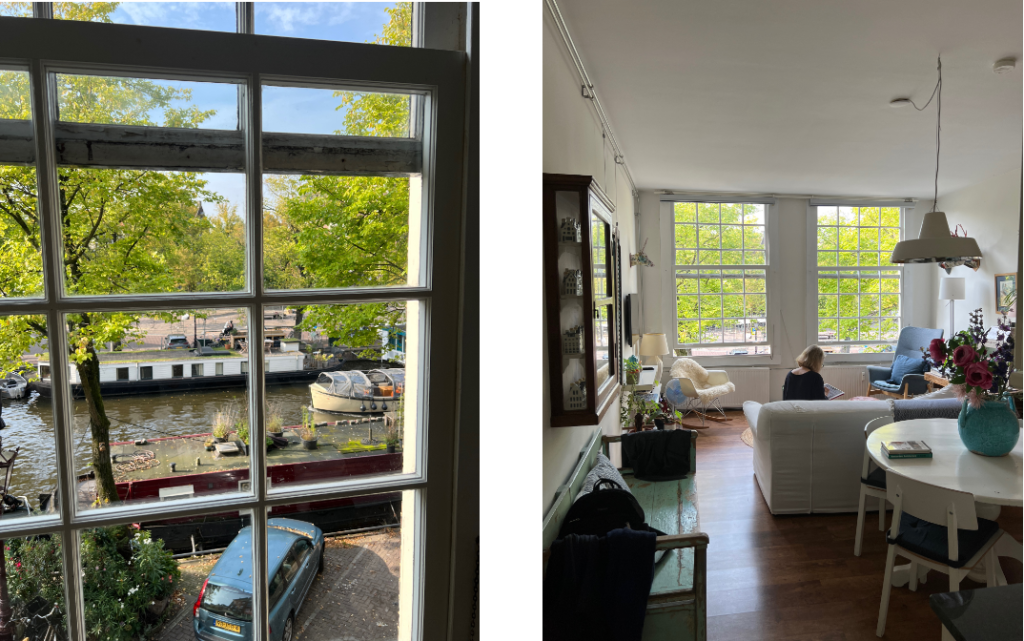
After settling in we napped for two hours, and arose surprisingly refreshed – that is to say, not horribly groggy. There is still a veil of fatigue between us and the world, but it is not bad. We walked a big loop through the neighborhood where we’re staying. Mostly we checked out the locations of things for future reference, though we did have a light meal of tapas (unexceptional) on Harlaamstrat, with beer and wine, and picked up a few things at a grocery store near our apartment. Overall, we walked about 3.5 miles.
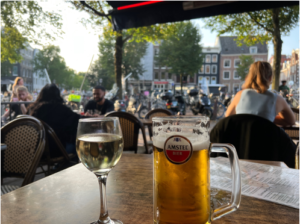
When we got home we collapsed into bed at about 8:00pm. I awoke, feeling reasonably refreshed and ready for a new day, but discovered it was 12:38am, and I needed to sleep longer! Katie also woke up, and we spent a couple hours reading, before falling asleep again, and this time slept until around 8am.
A walk, and great pumpkin soup
Tuesday, October 3 – 1.5 miles
We were pleased to be up at a normal-for-Amsterdam hour, and although, still a bit fatigued, felt pretty well. It was gray with intermittent light showers, but after lolling about and having a leisurely breakfast we set out to explore the Jordaan neighborhood. (Yesterday our walk, as it turned out, missed most of the neighborhood). The first stop was a pharmacy, where I picked up some oormeer softener – that being Dutch for ear wax (I used foam ear plugs on the plane, and one of the appears to have jammed wax into a plug in my ear canal, resulting in a partial deafness on my left side). (When we returned home I used it, and it solved the problem, so no more to be said).
By this time we’d gotten hungry and went looking for a lunch place. It was surprisingly difficult to find something that was open. Apparently restaurants often close on Tuesdays, and sometimes on Wednesdays. Finally we found a nice café, and sat outside under an awning at a small corner table, and had a delicious spicy pumpkin soup (along with a beer for me). The rain picked up, but it came straight down so we stayed dry and happy. Very cozy, and very sustaining! (We will have to explore pumpkin soup recipes at home when we return.)

After lunch we returned to the apartment, and kicked back for a few hours, reading and writing. Katie researched options for the next day, I worked on finishing my Yosemite trip report for my blog, and did other online things, and we had a relaxed afternoon. As evening fell, we got hungry, and went across the canal where we got take-out at a small Indonesian place; we brought it home, had a nice meal, and returned to our various pursuits. We stayed up until about midnight, and then had a good – if drug-assisted – night’s sleep.
SLA lunch, and a meander around Jordaan
Wednesday, October 4 – 5 miles
We rose around 8:00, had breakfast, and read and wrote for a couple of hours. No doubt this will be a regular pattern.
Then we went out and had lunch at SLA, a chain of vegetarian restaurants that we’ve eaten at before. It was quite good – I had a flafel salad with all sorts of other things in it. Katie had something similar. After that we did a tour of the Jordaan neighborhood that we found on the app GPSmyCITY.com, an app which apparently allows people to publish their own tours. The guide was pretty good at getting us around the neighborhood; however, we didn’t really want to go to museums today, and instead just enjoyed the walk. Katie was intrigued by the church, xxx, which was extremely spare, and oriented along a diagonal: she believes it may represent a reaction against the ornamentation of catholic churches. [check] The nicest part of the tour was walking along a very small street called Nieuw Leliestraat. Both because the street had nice gardens, and because it wasn’t very trafficked (it gets a bit tiring watching out for both cars and bicycles – pedestrians are clearly at the bottom of the hierarchy here).

After the walk, we returned to the apartment and read and had short naps. Then we went out to dinner at Moeder’s – that’s Dutch for Mother’s. It’s a bit gimmicky in the the walls are totally covered with small pictures of mothers, which apparently anyone can send in. Still, we had great pea soup – something we had pleasant memories of from our last visit, and that we’d been looking forward to since our arrival. My main course was good – spare ribs – but Katie took a chance on a vegetarian casserole type dish and it turned out that it was almost entirely composed of nightshades. Too bad, but at least the pea soup was a hit.
Our walk to and from dinner came to a bit over two miles; I neglected to record our earlier walk, but as it took us within a block or two of Moeder’s, but by a considerably more circuitious route, I’ll call it a minimum of 3 miles, making this a 5 mile day.
Pancakes and the Rijksmuseum
Thursday, October 5 – 6.5 miles
We rose around 8:00, had breakfast, and read and wrote for a couple of hours. Today we have more ambitious plans, which at the minimum will involve museums. Just now we are planning on walking to the Rijksmuseum, and exploring it and the adjacent park. It’s about half an hour’s walk each way, which sounds pleasant.
We began with lunch at the Pancake Café. I had an apple-bacon pancake, and Katie had a gluten-free spinache-cheese pancake. They were big and quite flat, very much like French crepes, except with the extras incorporated into the pancake itself – although given their thinness, the ingredients tended to protrude. They were good, but I don’t believe either of us would say they were wonderful (Katie was hoping for a puffy pancake, as in a German apple pancake). But no complaints. We will probably return to this café, but more likely for a lunch of pea soup.
After a brief stop at our apartment – the Pancake Café is nearby – we headed out to the Rijksmuseum. We took a slightly oblique route – we wanted to walk along less-trafficked streets, and were also interested in passing by the place we’d stayed in 2020, and so we walked over to Herrengracht and thence to the museum. We arrived at about 2:45, and upon enquiring for the ticket office discovered tickets were only available online. But that wasn’t so bad, as I could just go online, order them, and download them. Five minutes later we were in the entrance queue, and pleased that they were not enforcing entrance times, as we would have had to wait half an hour. So in we went. Soon we were in the 17th & 18th C rooms looking at Rembrants, Vermeers, and the like. One thing I appreciated was that the Rijksmuseum had large plastic placards (in holders on the walls) that featured one or more nearby pictures, and highlighted some of the features of note. For example, on placard showed Rembrant’s picture of a wealthy Dutch man dressed in his finery, and noted the techniques he used to make the fabric glisten and the fine lace stand out (for the latter, rather than painting the lace with white, he layed down a background of white, and used black to paint the holes that patterned the lace). In another case, “The Threatened Swan,” its placard noted that the swan’s feathers, which appear white, are actually painted with touches of multiple colors.

It was also nice to see the Vermeers. Katie enjoyed them as well, and remarked that she was surprised at how small they were.

The Vermeer show had closed, but they still had the Vermeers in their own collection among them, The Love Letter, Woman Seated at a Virginal, and The Milkmaid. The ever-informative placards called attention the way in which several of the paintings set their subjects a distance from the viewer (e.g., behind a table), and feature a single point of movement (here, the pouring milk) amidst stillness. The Milkmaid was my favorite of these. I like the calmness and focused concentration of the subject pourng the milk in an otherwise motionless scene. I was perhaps also primed to appreciate The Milkmaid because I’d come across a Banksy play on it a few days earlier. No doubt you can tell which is which.
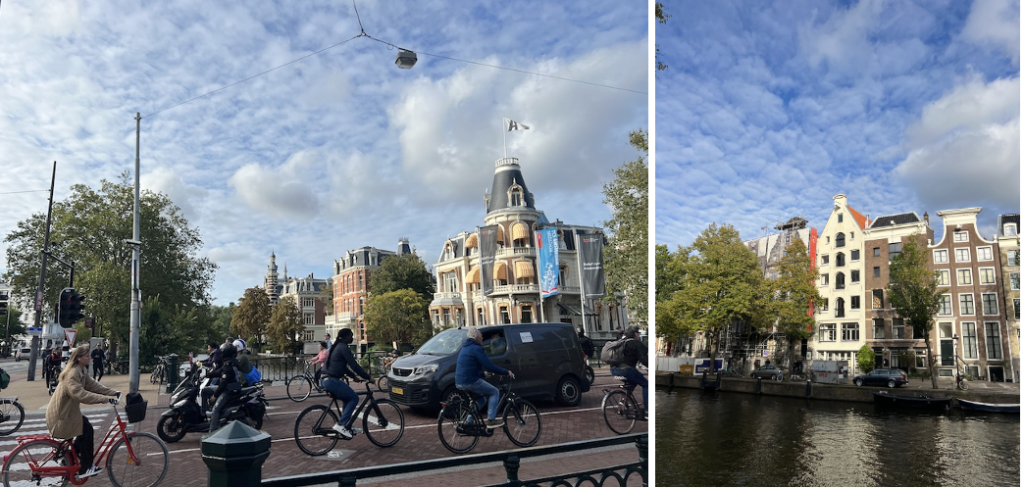
We spent an hour and a half looking, which is about all that I can manage before feeling satiated, and then departed as the first closing announcements were broadcast through the museum; we shall return another day. We walked home, partially retracing the route we came on, and with our goal accomplished paid more attention to the people and streets and canals and buildings. We picked up dinner at the Indonesian place, I made a quick trip to the grocery store, and we settled in for the evening.
Rembrandthuis and Amsterdam University
Friday, October 6 – 7.5 miles
We rose around 8:00, had breakfast, and read and wrote for a couple of hours. Today our plan is to visit the Rembrandthuis museum, a refurnishing of the rooms of the house Rembrandt lived in during this peak years. He later fell out of style, was unable to maintain his house, and sold off much of the furnishings. This process produced itemized lists which were used in the refurnishing. The house museum is a walk of about 35 minutes, into Central Amsterdam (aka the red light district) and then the Nieumarket, areas we’ve not explored yet. In addition to the museum, I’m especially interested in seeing the Begijnhof.
Before we set out for the day, I went out to find an ATM, and turned it into a short walk. The day was lovely; sunny and in the high sixties.Many people were out and about. I walked about a mile and a half, but other than enjoying my walk have nothing to report.
I returned to the apartment, and after finishing up our leftovers for lunch, we set out for the Rembrandhuis Museum. As we headed east towards the shore, where the museum is located, the streets grew busier and busier. I presume the increased density is due to tourists, and those servicing them. Although we passed through the red light district, we apparently bypassed the racy part; I noticed nothing. Rembranthuis Museum is the original house Rembrandt lived in, abutted by a modern building that houses the museum ‘infrastructure’ – ticket collection, audio tour distribution, and galleries. After picking up the audio tour, which consists of a tablet with headphones, we passed through an entrance into the house itself. It was a little confusing a first, because the tablet interface offers a couple of rows of buttons which select the audio for each room, and at the right is a button for entrance room – but that refers to the house entrance, which is on the first floor, when the room one enters into when entering the museum is the kitchen. It didn’t take long to figure out, but I have to say that the interface was a little clunky.
The house is quite large, especially for the time, and had luxurious items like running water – via a pump – in the kitchen. That said, furnishings were quite sparse. The parlor – it had a different name but its where he saw clients and conducted business – had only a single chair. It’s not what I would have expected a place where you met clients and shared wine. Most rooms had – again I forget the proper name – closet beds: they were short — only about four feet long — and were essentially built-ins with doors. Apparently, during that period, people believed it was unhealthy to sleep laying down, and so beds were short to enable sleeping in a sitting posture. I imagine the doors were there to conserve heat, though no doubt, closed up during the day, they also made the house look tidier.
The most interesting room in the house was Rembrandt’s studio. The large one was Rembrandt’s private studio. It had floor to ceiling windows, facing north – a direction favored by painters for the consistency of the light throughout the day – a large easel, and shelves of art materials ranging from props used in paintings to materials and apparatus for making paint. I found the paint-making of most interest: in those days, paints had to be made from scratch: black from charcoal, white from lead, yellow and red-brown from clay, bright red from cochineal, and blue from cobalt glass. The materials had to be reduced to power – if not clay – and mixed with linseed oil in a laborious and rather elaborate process; left over paint would be stored in small pots covered with an oiled cloth. I don’t know, but I presume that painters pallets were less well-populated in those days.
After Rembrandthuis we shared a salad at a café to refuel, and then made our way to the Begijnhof. But as we walked, Katie grew curious about people streaming out of an passage, and so we altered our course. At first we were in a narrow alley that had cupboard like areas on either side being used as book stalls; most were closed, but those that were opened featured books, mostly used, and various manuscripts. It was intriguing. Venturing farther the alley opened into quadrangles with grass and lovely gardens, and we found that we were on the grounds of the University of Amsterdam. Katie enjoyed the collegial atmosphere and students bustling about.
Having satisfied our curiousity, we proceeded on to the Begijnhof. The Begijnhof was originally housing for widows – it was something like a convent, except, as the guidebook noted, the occupants did not take a vow of celibacy. Regardless, it was a square of houses with their backs to the city, opening onto a mostly grassy commons. It was beautiful and tranquil. The last genuine widow of Begijnhof died in 1971, and these days it appears to be housing open to anyone. It would be a lovely place to live, except for the stream of tourists during visiting hours, which are most of the day until 6:00.

Interlude: A night view of the canal
Here is a night view from our window looking out over the canal, with a houseboat on the right.

Boswell, Saturday market and mushrooms
Saturday, October 7– 1 mile
We had a slow morning. Katie had difficulty getting to sleep, and slept in; I rose and read. After perusing the news, and reading some of the geology subs on reddit, I picked up Boswell. Almost as an after-thought, as we were preparing to leave, I decided to bring “Boswell in Holland,” one of his earliest journals. I had hoped that he had spent time in Amsterdam, and that it would afford some places to visit, but he appears (as far as I’ve thus read) to spend the vast majority of his time in Utrecht, where he is studying law. And, even with Utrecht, in the usual Boswellian manner, he pays far more attention to people and society than to places.
Boswell hated Utrecht at first. He arrived and fell into a depression. He writes:
I have been at Leyden; from thence I went to Utrecht, which I found to be a most dismal place. I was there entirely by myself and had nobody to speak to. I lived in an inn. I sunk altogether. My mind was filled with the blackest ideas, and all my powers of reason forsook me. Would you believe it? I ran frantic up and down the streets, crying out, bursting into tears, and groaning from my innermost heart. O good God! what have I endured! O my friend, how much was I to be pitied! What could I do? I had no inclination for anything. All things appeared good for nothing, all dreary. I thought I should never recover, and that now the time was come when I should really go mad.
Boswell had struggled with depression before, so this was not unprecedented, and not entirely unexpected given that the he has been, for the first time, been separated from family, friends and associates. He has come to Utrecht to study law – Dutch law apparently derives a lot from Roman law, on which Scottish law is also based – at the behest of his father. Boswell would much prefer the life of a gentlemen, man-about-town, and literati, and has resisted studying the law for some time. But it seems clear that if he wishes to inherit his father’s estate, Auchinleck, and live a life as a comparatively wealthy man, he needs to adhere to his father’s wishes.
To jump ahead in the journal, after sending off several highly distressed letters (the passage above is a quote from one of his letters), Boswell gets ahold of himself, and, in keeping with the counsel of several of his friends, develops a plan that includes regular study of law and languages, regular exercise, and moderation in eating and drinking and other behavior. He manages to carry out his plan, and ends up following, modulo various relapses, for the nine months he spend in Utrecht. In his journal, he begins each entry by reflecting on his behavior the day before, noting whether he followed the plan or deviated from it (“was irregular”), and praising or critiquing himself accordingly. He also shares these notes with his friends, and receives encouragement, praise and advice from them. He is clearly very dependent upon support from others, both his distant friends, and less intimate but at-hand acquaintancesin Utrecht.
#
At length Katie arose, and we chatted for a bit as we had a late breakfast. Strains of music and the murmur of mass conversation from across the canal reminded us that the Saturday street market was under way, and so once we were done with breakfast we headed out to market. It was fun to be amidst the hustle and bustle. We came to a stall with a large selection of mushrooms., and decided we would buy some and make dinner at our apartment. There was also a stall with gouda made from sheep and goat milk, and so we got a wedge of that as well, along with half a loaf of bread for me.

We returned home, mapped out a dinner, and I went to the market and got the remaining ingredients, as well as some beer and chocolate for myself. We spent the afternoon in the apartment, writing, napping (me, after having my beer), and snacking on some of the cheese. Then, we made dinner: a salad with argula, radish sprouts, and rose apples (which to our surprise had red flesh); and the mushrooms (fresh porchini, boletus, and a wild mushroom mix. The porchine were supberb, the mix was good, and the boletus not to our taste. It was great fun to make dinner together!
The boat tour
Sunday, October 8 – 4 miles
We followed our usual pattern in the morning, and then made lunch for ourselves using the remnants of yesterday’s dinner: a salad with smoked salmon, the latter of which I got from the store. After lunch Katie stayed in and wrote, and I went out to get cash from the ATM and then took a walk to Westerpark. Obviously it is a park; I thought, from looking at the pattern of paths on the map, that it might be a botanical garden, but that part turned out to be some sort of zoo – that’s the disadvantage of not knowing Dutch. The park was OK if very heavily used, but it did not measure up to the best urban parks, like Kensington Gardens. Still, it was a pleasant walk of almost 4 miles, and I’m glad I went.
The big event of the day was the boat tour. We had read in the description of our rental that our host gave private boat tours, and as reviews had commented favorably on them we had arranged one for 3:30. Initially it had be planned for Saturday, but we shifted to the Sunday because warmer weather had been forecast. As it turned out, Sunday was about the same as Saturday in terms of weather, so we made sure we had jackets and extra warm clothing when we set out. Our host and guide, Rob, was amiable and quite knowledgeable about architecture. I wish I’d thought to turn on the GPS tracker so we could have a record of where we went, but I did not. Still, we toured around the canals in the old city – through Jordaan, Central City, the red light district, the university area, and others – and then left the main part of the city and went out along the Amstel river to Amsterdam Noord.

North Amsterdam is a former (mostly) industrial area where there were ship yards and other large scale industries. Those have mostly departed and the factories and warehouses have been repurposed into social housing, hotels, restaurants and the like. Some areas are hip, having been pioneered by squatters, with the sort of street art, colorful sculptures and one-of-a-kind businesses one would expect.

There were also a lot of modernist buildings, their appearances ranging from striking to ugly. Rob gave us a running commentary – well, really, it was nicer than that, let’s call it a long conversation, about the various sites and their history. It was a lot of fun. And apparently he enjoyed it as well, as we went an hour over the advertised 2.5 hour duration, and he probably would have spent another hour with us if we hadn’t decided it would be good to go back. And we were plenty warm the whole time.

Het Schip
Monday, October 9 – 4 miles
On our last full day in Jordaan our principle outing was to visit Het Schip, a modernist housing project built in the 20’s intended for workers. As below, it has wonderful brickwork at both large scales
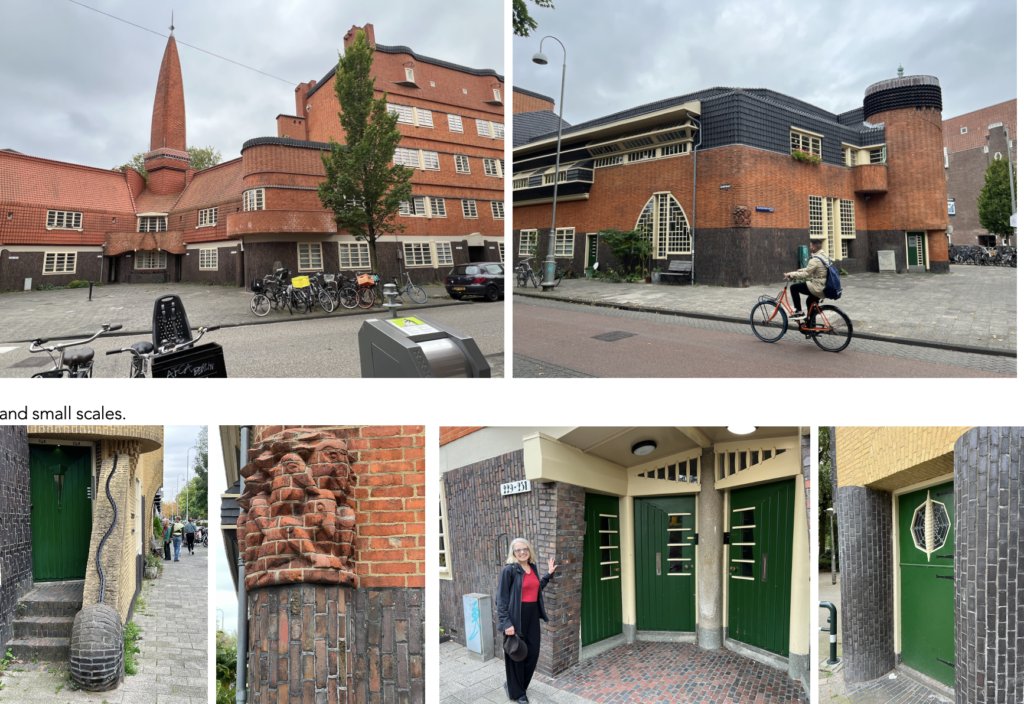
and small scales.
Moving day and our new apartment
Tuesday, October 10 – 3.5 miles
This was moving day. It could not have gone more smoothly. We packed up, got picked up by a taxi at 11:00, and were able to drop our bags in the new place at 11:30. Then we went out and explored a bit of our new neighborhood, and had lunch, until we took possession at 1:15 after it had been cleaned.
It is a lovely modern apartment with a great view out over the Amstel river. I think we’ll be happy here.
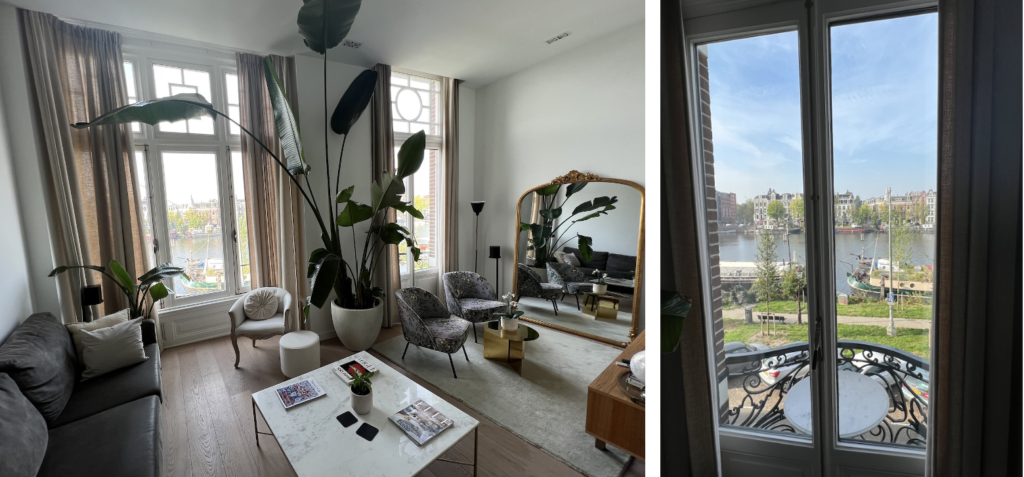
We settled in, hung out for a bit, and then went out for a casual dinner at Lulu’s pizza, just down the street.
De Kas farm to table
Wednesday, October 11 – 3.5 miles
The main event of the day was lunch at De Kas, one of the first farm to table restaurants. It is located in a restored greenhouse which provides a light and airy setting (and, contrary to my fears, was not at all hot).
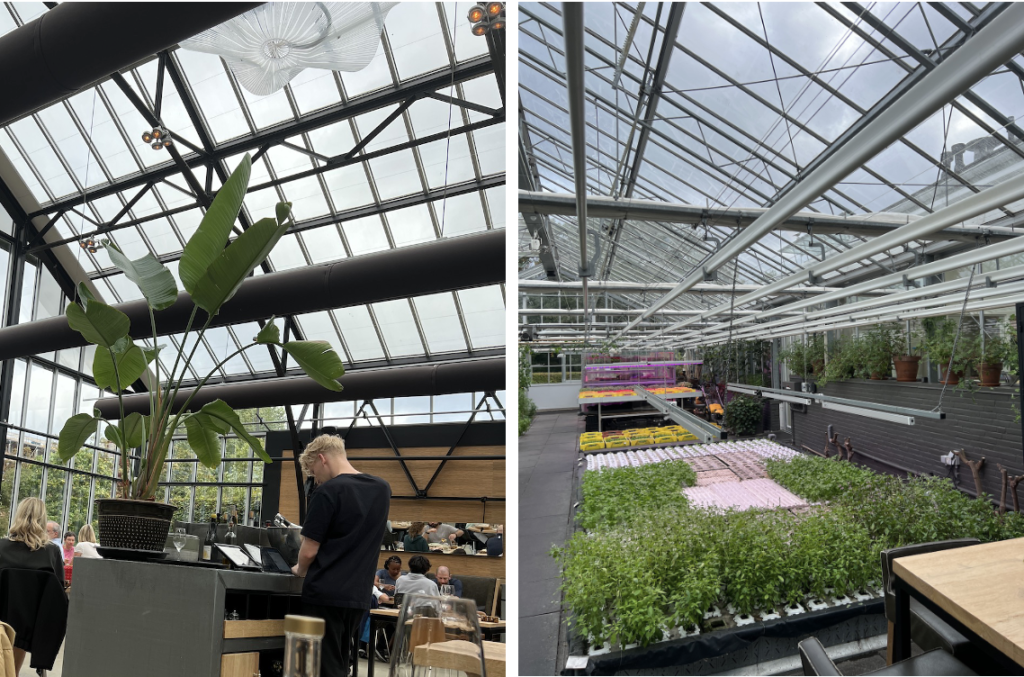
The food was beautiful, and very tasty. It turned out to be, for the most part, quite rich. We got more than our quote of butterfat!
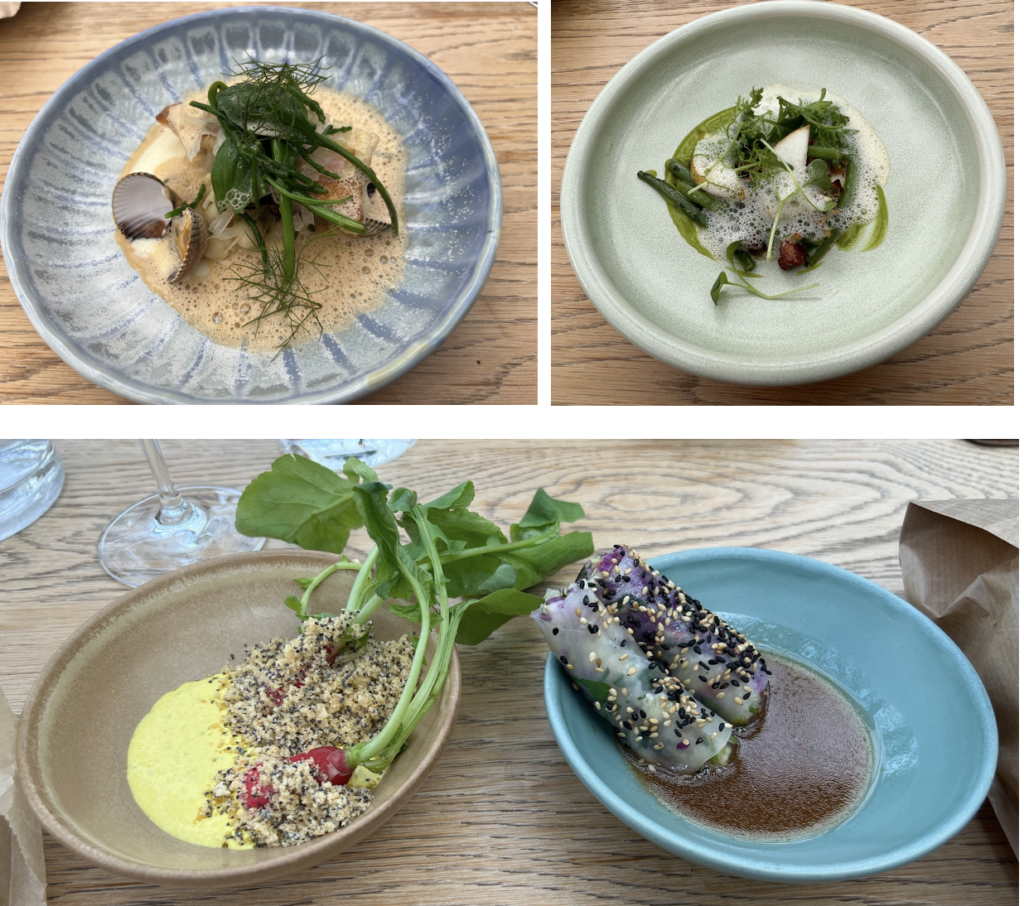
The De Groote ‘Everything is connected’ museum
Thursday, October 12 – 3 miles
We went to a science museum: the De Groote.
They had taken over what used to be a 19th Century Natural History museum, stuffed with curiosities gathered, in the says of empire, from across the globe. Renovating the space, and sending most of its artifacts off to new homes – excepting the 10-foot Sperm Whale penis, they filled it with new exhibits. While not abjuring specimens and taxidermy and bones, the aim of the new museum was to showcase the interrelatedness of life, and to make the point that humans are a part of nature, and not something special. Thus, an exhibit that focused on the importance of the human spine – and the way in which its form had evolved to support humans as long distance runners and predators – was surrounded by exhibits that highlighted the roles of spines in other fomrs of locomotin in other creatures. It was probably the best science museum I’ve been too; they did an amazing jog at creating engaging interactive exhibits and beautiful animations.
We returned to the apartment and rested for a bit. Then we had trouble, searching online, finding a place that we could get reservations at. Finally we came up with some places that we hoped would do walk-ins. Then we set out, and discovered that right next door was a nice restaurant with a good menu and that could accommodate us.
The Rijksmuseum – ancient and modern art – and a great dinner
Friday, October 13 – 6 miles
We ate lunch at the apartment, trying to use up most of our grocery-store food.
Then we set out for the Rijksmuseum. It was a rainy and quite windy day, so the walk was a bit damp and blustery. Arriving at the Rijksmuseum we started out with early painting, 1100-1600. I most enjoyed the landscapes, and the scenes of everyday life. The depictions of religious stories don’t engage me, and the depictions of Greek mythology are not much better, although sometimes it is fun to test my knowledge of mythology.
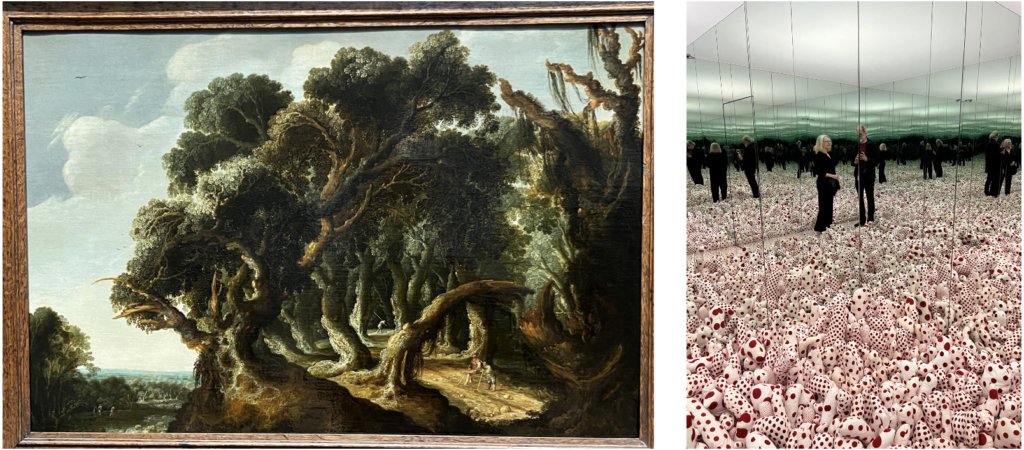
Then we went to a modern exhibition. The spare settings and the larger paintings were a nice break from the older paintings. Perhaps the most interesting aspect of it was the infinity room by Yayoi Kusama.
Then we had a rainy walk to dinner at XXXX. It is one of the new cool restaurants, and doesn’t take reservations, so we made an effort bo be there when it opened at 5:00. We were the first there, and had the place to ourselves for about 20 minutes. Then it began to fill up faster and faster, and by the time we ordered our main courses, the restaurant was full. Dinner was great! They did fantastic things with vegetables – notably a carrot dish and then a Jerusalem artichoke dish. Our main courses, duck and haibut, were also excellent.
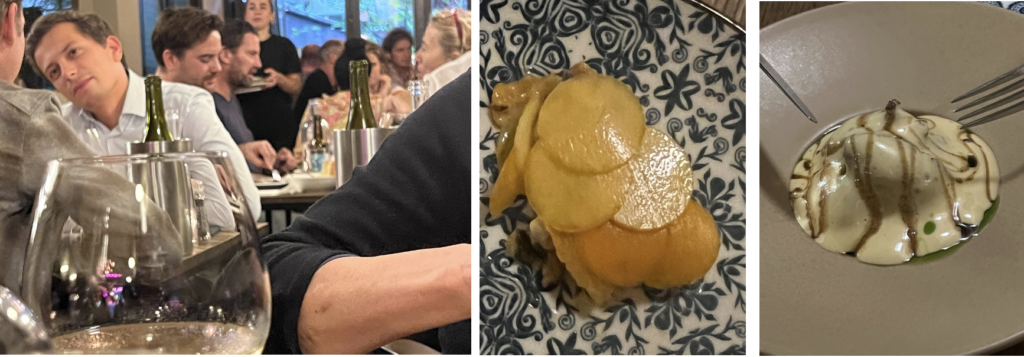
Then we came home – rain had stopped — and packed.
Going home
Saturday, October 14:
We finished packing and took an Uber to the airport. After some dithering, I had decided we should arrive three hours early, as Delta recommends for international travel. This seemed excessive, at least for MSP, but I was nervous about the complexity of Schipol, and the lack of things like curbside check-in and TSA Pre.
It was a good thing we were early – it took us nearly an hour and a half to get through the various lines: one line to check in (a short one, given that we were Sky Priority; one very slow line to run our boarding passes through a reader and get access to the concourse that included our gates; another line to go through passport control; and a yet another line to go through security. Had we looked around more, it might have been possible to find a faster security line for ‘elite’ passengers…
Anyway, we got through all the lines, and made it to the E-concourse with time to buy water, chocolate and grab some takeout sushi for a quick pre-flight snack. Then we boarded, went to our separate seats : – (, and flew home.
A nice bonus was that we flew over Greenland, and the sky was clear enough and the plane low enough that there were some great views of glaciers.
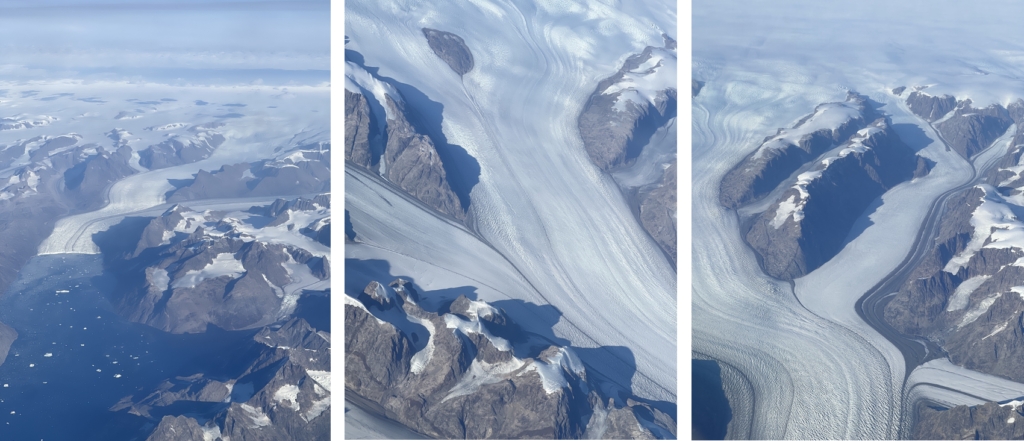
Views: 7